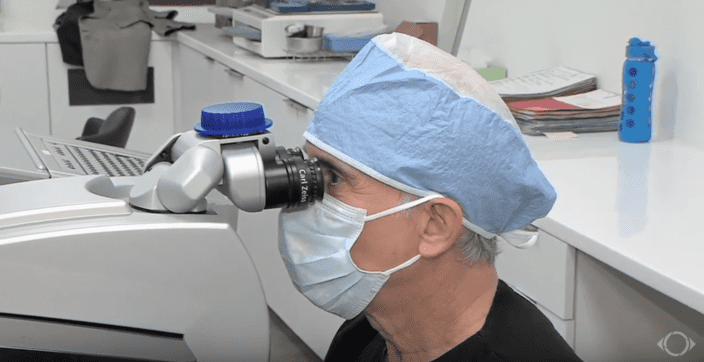History of LASIK: Invention, Iteration & Current Status
Last Updated:

Article At a Glance
The laser developed for LASIK surgery was created in the 1970s, but it took until 1995 for the U.S. Food and Drug Administration (FDA) to approve it for eye surgery. Initially, eye doctors used the laser to treat myopia.
Table of Contents
During the decades between invention and approval, doctors and scientists refined the LASIK procedure, which grew increasingly safer and more effective. It is now one of the most common types of corrective eye surgery.
By 2021, LASIK patients had several types of laser eye surgery to discuss with their eye doctors as treatment options. Now the vision correction procedure can be customized for individual needs.
LASIK continues to evolve, and its success and safety record push doctors and scientists to explore more ways to make it even more effective for patients.
Who Invented LASIK?

Dr. Gholam A. Peyman, a retina surgeon and ophthalmologist, invented LASIK (laser-assisted in-situ keratomileusis). In 1989, he was awarded the first patent in the United States for this procedure. In addition to LASIK, Dr. Peyman holds 124 other patents in the U.S. for various intraocular drug delivery systems, new treatment and diagnostic methods, medical devices, and surgical techniques.
In 1991, LASIK was first performed in clinical trials in the U.S. In the years since, various techniques and advancements have been developed in regard to LASIK surgery. Dr. Peyman is responsible for some of these, but other medical and scientific professionals have also made numerous contributions to the improvement of LASIK.
How Was LASIK Created?
LASIK exists thanks to the invention of the excimer laser. This gas laser works by emitting light pulses in the ultraviolet spectral range. In 1970, this laser started being used experimentally.
The technique that inspired LASIK was first used in 1948 to correct a refractive error. It was a stromal sculpting method developed by José I. Barraquer Moner. In the first procedure he performed, he froze an anterior corneal tissue disc and then used a lathe to remove stromal tissue.
You deserve clear vision. We can help.
With 135+ locations and over 2.5 million procedures performed, our board-certified eye surgeons deliver results you can trust. Your journey to better vision starts here.
As the years passed, the technique continued to develop. Eventually, in-situ keratomileusis was created. This involved passing the microkeratome right on the stromal bed a second time, thanks to the invention of the automated microkeratome. This procedure was referred to as automated lamellar keratoplasty.
Further refinements were made due to this automated tool. This resulted in doctors being able to replace the disc without having to use any sutures. In 1989, this was first demonstrated.
In 1988, the excimer laser was used for the first time to sculpt from a stromal bed. This happened below a hinged flap that the surgeon used a scalpel and trephine to create manually. In 1990, the microkeratome was introduced into the equation to result in the LASIK procedure that doctors are using today.
How Has LASIK Evolved Over the Years?
The biggest advancements in LASIK include the microkeratome and the excimer laser. However, more recent advancements are due to wavefront technology and the femtosecond laser. For contemporary LASIK surgery, these two advancements have become the gold standard.
The femtosecond laser is used in bladeless LASIK surgery. Instead of using the microkeratome, surgeons are using this laser when creating the flap that is necessary for the procedure. These lasers put out ultrashort pulses of energy operating in the infrared wavelength. This allows for greater precision when the surgeon is cutting the flap.
The advantages of the femtosecond laser include:
- Few complications associated with the flap.
- Reduced epithelial ingrowth incidence.
- Hinge position flexibility.
- More precise control over hinge width and flap diameter.
- Less variability in flap thickness.
- Improved visual outcomes.
Wavefront LASIK allows for greater personalization and precision. It evaluates a person’s unique eye characteristics before the surgery. The excimer laser is programmed with this information to allow for the reshaping of the eye.
Compared to traditional LASIK, wavefront LASIK is superior because it is more precise and specific.

You deserve clear vision. We can help.
With 135+ locations and over 2.5 million procedures performed, our board-certified eye surgeons deliver results you can trust. Your journey to better vision starts here.
What Types of Laser Eye Surgery Are Available?
There are a few different types of laser eye surgeries available. There were an estimated 718,000 U.S. LASIK surgeries in 2020. That number has increased over the past five years but is below the record total of 1.03 million procedures in 2008.
LASIK
The most common method to treat hyperopia, myopia, and astigmatism is LASIK surgery. It works by reshaping the cornea. Following reshaping, vision becomes clearer because light more accurately focuses on the eye’s retina.
This procedure involves using a femtosecond laser or a microkeratome to create a corneal flap. An excimer laser is used to remove some corneal tissue to reshape, smooth, or flatten the cornea, depending on the refractive error present.
PRK
Photorefractive keratectomy (PRK) is used for hyperopia, myopia, and astigmatism. Compared to LASIK, the recovery time is usually longer. It also uses an excimer laser to reshape the cornea. Unlike LASIK, the surgeon removes a thin part of the epithelium of the cornea and discards it instead of creating a flap that is put back into place. Within a few days of the procedure, the epithelium repairs itself.
LASEK
This procedure combines elements of PRK and LASIK. Like with PRK, a thin piece of the epithelium is separated from the stromal layer. It isn’t discarded, however. Instead, it is repositioned to reattach itself, as with LASIK. LASEK also uses an excimer laser to reshape the cornea. It can be used for hyperopia, myopia, and astigmatism.
What Is the Future of LASIK?

At the University of Maryland, researchers are looking to remove the surgery element of LASIK. They are looking at a microscopy technique that would eliminate surgeons from making approximations. Instead, they will use measurements that are precise regarding how the eye focuses light.
This technology would allow doctors to map the variations and distribution of the eye’s local refractive index. As a result, they would have the precise degree of corneal refraction. With this advancement, surgeons could more definitively provide patients with 20/20 or greater vision. It could also potentially eliminate the need to cut into the cornea to perform LASIK.
Some scientists are trying to find ways to eliminate the need to use lasers for LASIK. Instead, they are brainstorming ways to use eyedrops to correct refractive errors. While this advancement could be possible, it is still believed to be decades away.
You deserve clear vision. We can help.
With 135+ locations and over 2.5 million procedures performed, our board-certified eye surgeons deliver results you can trust. Your journey to better vision starts here.
References
- The History of Refractive Surgery. (December 2013). IREO International.
- Custom Wavefront LASIK: Personalized Vision Correction. All About Vision.
- Creating LASIK Flaps: Femtosecond Laser vs. Mechanical Microkeratome. (July 2007). American Academy of Ophthalmology.
- A Look at LASIK Past, Present, and Future. (June 2009). American Academy of Ophthalmology.
- Eye Health Statistics. (2015). American Academy of Ophthalmology.
- Direct Three-Dimensional Measurement of Refractive Index via Dual Photon-Phonon Scattering. (March 2019). Physical Review Letters.
- The LASIK Procedure: A Brief Guide. All About Vision.
- PRK Laser Eye Surgery: How It Differs From LASIK. All About Vision.
- The history of LASIK. (April 2012). Journal of Refractive Surgery.
- A Look at LASIK Past, Present and Future. (June 2009). American Academy of Ophthalmology.
- Laser In Situ Keratomileusis. (July 2021). National Library of Medicine.
- Number of LASIK surgeries in the United States from 1996 to 2020. (2021). Statista.
- Milestones in LASIK. (April 2011). Ophthalmology Management.
This content is for informational purposes only. It may have been reviewed by a licensed physician, but is not intended to serve as a substitute for professional medical advice. Always consult your healthcare provider with any health concerns. For more, read our Privacy Policy and Editorial Policy.